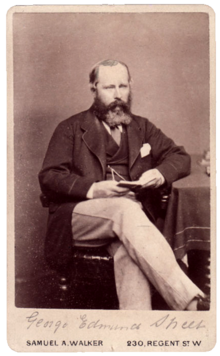G.E. Street
| George Edmund Street | |
|---|---|
 |
|
| Born |
20 June 1824 Woodford, Essex |
| Died | 18 December 1881 (aged 57) London |
| Occupation | Architect |
| Awards | Royal Gold Medal (1874) |
| Buildings | Royal Courts of Justice, The Strand, London |
George Edmund Street RA (20 June 1824 – 18 December 1881), also known as G. E. Street, was an English architect, born at Woodford in Essex. Stylistically, Street was a leading practitioner of the Victorian Gothic revival. Though mainly an ecclesiastical architect, he is perhaps best known as the designer of the Royal Courts of Justice, on the Strand in London.
Street was the third son of Thomas Street, a solicitor, by his second wife, Mary Anne Millington. He went to school at Mitcham in about 1830, and later to the Camberwell Collegiate School, which he left in 1839. For a few months he worked in his father's business in Philpot Lane, but on his father's death he went to live with his mother and sister at Exeter. There his thoughts first turned to architecture, and in 1841 his mother obtained a place for him as pupil in the office of Owen Browne Carter at Winchester. Afterwards he worked for five years as an "improver" with George Gilbert Scott in London.
His first commission – undertaken while still working for Scott – was for the design of Biscovey Church, Cornwall. In 1849 he set up in practice in an office of his own. Much of his earliest work, which included many church restorations, was in Cornwall.
In November 1850, having been appointed architect to the diocese of Oxford he left London, and moved to Wantage, where he had already designed a vicarage, and was working on some schools. In May 1852 he went to live in Beaumont Street, Oxford. He designed the parish church of SS Philip and James in the city, and another at Summertown, as well as restoring many others, but his only work for the university was the reordering of Jesus College Chapel. His son, Arthur Edmund Street suggested that:
...
Wikipedia
